Critical Analysis of Association Constants between Calixarenes and Nitroaromatic Compounds Obtained by Fluorescence. Implications for Explosives Sensing
Abstract
1. Introduction
2. Results and Discussion
2.1. Detection of Nitroaromatic Explosives
2.1.1. UV-Vis Absorption and Fluorescence Studies
2.1.2. NMR Studies
2.2. Computational Studies
2.2.1. Semiempirical Calculations
2.2.2. QM Calculations
2.2.3. MD Simulations
3. Materials and Methods
3.1. UV-Vis Absorption and Fluorescence Studies
3.2. 1H NMR Studies
3.3. Computational Details
3.3.1. QM/MM Calculations
3.3.2. DFT Calculations
4. Conclusions
Supplementary Materials
Author Contributions
Funding
Institutional Review Board Statement
Informed Consent Statement
Data Availability Statement
Acknowledgments
Conflicts of Interest
Sample Availability
References
- Sun, X.; Wang, Y.; Lei, Y. Fluorescence based explosive detection: From mechanisms to sensory materials. Chem. Soc. Rev. 2015, 44, 8019–8061. [Google Scholar] [CrossRef] [PubMed]
- Martelo, L.M.; Marques, L.F.; Burrows, H.D.; Berberan-Santos, M.N. Explosive detection: From sensing to response. In Fluorescence in Industry; Pedras, B., Ed.; Springer Series on Fluorescence; Springer: Cham, Switzerland, 2019; Volume 18. [Google Scholar]
- Moore, D.S. Recent advances in trace explosives detection instrumentation. Sens. Imaging. 2007, 8, 9–38. [Google Scholar] [CrossRef]
- Meaney, M.S.; McGuffin, V.L. Luminescence-based methods for sensing and detection of explosives. Anal. Bioanal. Chem. 2008, 391, 2557–2576. [Google Scholar] [CrossRef] [PubMed]
- Rasheed, T.; Nabeel, F.; Rizwan, K.; Bilal, M.; Hussain, T. Conjugated supramolecular architectures as state-of-the-art materials in detection and remedial measures of nitro based compounds: A review. Trends Anal. Chem. 2020, 129, 115958. [Google Scholar] [CrossRef]
- Kumar, R.; Sharma, A.; Singh, H.; Suating, P.; Kim, H.S.; Sunwoo, K.; Shim, I.; Gibb, B.C.; Kim, J.S. Revisiting fluorescent calixarenes: From molecular sensors to smart materials. Chem. Rev. 2019, 119, 9657–9721. [Google Scholar] [CrossRef]
- Desai, V.; Panchal, M.; Dey, S.; Panjwani, F.; Jain, V.K. Recent advancements for the recognition of nitroaromatic explosives using calixarene based fluorescent probes. J. Fluoresc. 2022, 32, 67–79. [Google Scholar] [CrossRef] [PubMed]
- Gutsche, C.D. Calixarenes, An Introduction; Monographs in Supramolecular Chemistry; The Royal Society of Chemistry: Cambridge, UK, 2008. [Google Scholar]
- Neri, P.; Sessler, J.L.; Wang, M.-X. (Eds.) Calixarenes and Beyond; Springer International Publishing: Cham, Switzerland, 2016. [Google Scholar]
- Lee, Y.H.; Liu, H.; Lee, J.Y.; Kim, S.H.; Kim, S.K.; Sessler, J.L.; Kim, Y.; Kim, J.S. Dipyrenylcalix[4]arene—A fluorescence-based chemosensor for trinitroaromatic explosives. Chem. Eur. J. 2010, 16, 5895–5901. [Google Scholar] [CrossRef] [PubMed]
- Zhan, J.; Zhu, X.; Fang, F.; Miao, F.; Tian, D.; Li, H. Sensitive fluorescence sensor for nitroaniline isomers based on calix[4]arene bearing naphthyl groups. Tetrahedron 2012, 68, 5579–5582. [Google Scholar] [CrossRef]
- Zhang, F.; Luo, L.; Sun, Y.; Miao, F.; Bi, J.; Tan, S.; Tian, D.; Li, H. Synthesis of a novel fluorescent anthryl calix[4]arene as picrid acid sensor. Tetrahedron 2013, 69, 9886–9889. [Google Scholar] [CrossRef]
- Cao, X.; Luo, L.; Zhang, F.; Miao, F.; Tian, D.; Li, H. Synthesis of a deep cavity calix[4]arene by fourfold Sonogashira cross-coupling reaction and selective fluorescent recognition toward p-nitrophenol. Tetrahedron Lett. 2014, 55, 2029–2032. [Google Scholar] [CrossRef]
- Boonkitpatarakul, K.; Yodta, Y.; Niamnont, N.; Sukwattanasinitt, M. Fluorescent phenylethynylene calix[4]arenes for sensing TNT in aqueous media and vapor phase. RSC Adv. 2015, 5, 33306–33311. [Google Scholar] [CrossRef]
- Bandela, A.K.; Bandaru, S.; Rao, C.P. A fluorescent 1,3-diaminonaphthalimide conjugate of calix[4]arene for sensitive and selective detection of trinitrophenol: Spectroscopy, microscopy, and computational studies, and its applicability using cellulose strips. Chem. Eur. J. 2015, 21, 13364–13374. [Google Scholar] [CrossRef] [PubMed]
- Dinda, S.K.; Hussain, M.A.; Upadhyay, A.; Rao, C.P. Supramolecular sensing of 2,4,6-trinitrophenol by a tetrapyrenyl conjugate of calix[4]arene: Applicability in solution, in solid state, and on the strips of cellulose and silica gel and the image processing by a cellular phone. ACS Omega 2019, 4, 17060–17071. [Google Scholar] [CrossRef] [PubMed]
- Prata, J.V.; Costa, A.I.; Teixeira, C.M. A solid-state fluorescence sensor for nitroaromatics and nitroanilines based on a conjugated calix[4]arene polymer. J. Fluoresc. 2020, 30, 41–50. [Google Scholar] [CrossRef]
- Barata, P.; Prata, J.V. Fluorescent calix[4]arene-carbazole-containing polymers as sensors for nitroaromatic explosives. Chemosensors 2020, 8, 128. [Google Scholar] [CrossRef]
- Miranda, A.S.; Martelo, L.M.; Fedorov, A.A.; Berberan-Santos, M.N.; Marcos, P.M. Fluorescence properties of p-tert-butyldihomooxacalix[4]arene derivatives and the effect of anion complexation. New J. Chem. 2017, 41, 5967–5973. [Google Scholar] [CrossRef]
- Miranda, A.S.; Marcos, P.M.; Ascenso, J.R.; Berberan-Santos, M.N.; Schurhammer, R.; Hickey, N.; Geremia, S. Dihomooxacalix[4]arene-based fluorescent receptors for anion and organic ion pair recognition. Molecules 2020, 25, 4708. [Google Scholar] [CrossRef]
- Miranda, A.S.; Marcos, P.M.; Ascenso, J.R.; Berberan-Santos, M.N.; Menezes, F. Anion binding by fluorescent ureido-hexahomotrioxacalix[3]arene receptors: An NMR, absorption and emission spectroscopic study. Molecules 2022, 27, 3247. [Google Scholar] [CrossRef]
- Cottet, K.; Marcos, P.M.; Cragg, P.J. Fifty years of oxacalix[3]arenes: A review. Beilstein J. Org. Chem. 2012, 8, 201–226. [Google Scholar] [CrossRef]
- Marcos, P.M. Functionalization and properties of homooxacalixarenes. In Calixarenes and Beyond; Neri, P., Sessler, J.L., Wang, M.-X., Eds.; Springer International Publishing: Cham, Switzerland, 2016; pp. 445–466. [Google Scholar]
- Wu, C.; Zhao, J.-L.; Jiang, X.-K.; Ni, X.-L.; Zeng, X.; Redshaw, C.; Yamato, T. Click-modified hexahomotrioxacalix[3]arenes as fluorometric and colorimetric dual-modal chemosensors for 2,4,6-trinitrophenol. Anal. Chim. Acta 2016, 936, 216–221. [Google Scholar] [CrossRef]
- Sarova, G.; Berberan-Santos, M.N. Stable charge-transfer complexes versus contact complexes. Application to the interaction of fullerenes with aromatic hydrocarbons. J. Phys. Chem. B 2004, 108, 17261. [Google Scholar]
- Spartan 20 software, Version 1.1.3; Wavefunction Inc.: Irvine, CA, USA.
- Sheehan, R.; Cragg, P.J. Supramolecular chemistry in silico. Supramol. Chem. 2008, 20, 443–451. [Google Scholar] [CrossRef]
- Sambrook, M.R.; Vincent, J.C.; Ede, J.A.; Gass, I.A.; Cragg, P.J. Experimental and computational study of the inclusion complexes of β-cyclodextrin with the chemical warfare agent soman (GD) and commonly used simulants. RSC Adv. 2017, 7, 38069–38076. [Google Scholar] [CrossRef]
- Gans, P.; Sabatini, A.; Vacca, A. Investigation of equilibria in solution. Determination of equilibrium constants with the HYPERQUAD suite of programs. Talanta 1996, 43, 1739–1753. [Google Scholar] [CrossRef]
- Menezes, F.; Fedorov, A.; Baleizão, C.; Valeur, B.; Berberan-Santos, M.N. Methods for the analysis of complex fluorescence decays: Sum of Becquerel functions versus sum of exponentials. Methods Appl. Fluoresc. 2013, 1, 015002. [Google Scholar] [CrossRef]
- Frisch, M.J.; Trucks, G.W.; Schlegel, H.B.; Scuseria, G.E.; Robb, M.A.; Cheeseman, J.R.; Scalmani, G.; Barone, V.; Petersson, G.A.; Nakatsuji, H.; et al. Gaussian 09, Rev. D.01. Wallingford, CT, USA. 2016. Available online: https://gaussian.com (accessed on 2 March 2016).
- Dapprich, S.; Komáromi, I.; Byun, K.S.; Morokuma, K.; Frisch, M.J. A New ONIOM implementation in Gaussian 98. Part 1. The calculation of energies, gradients and vibrational frequencies and electric field derivatives. J. Mol. Struct. THEOCHEM 1999, 461–462, 1–21. [Google Scholar] [CrossRef]
- Chai, J.-D.; Head-Gordon, M. Long-range corrected hybrid density functionals with damped atom-atom dispersion corrections. Phys. Chem. Chem. Phys. 2008, 10, 6615–6620. [Google Scholar] [CrossRef]
- Ditchfield, R.; Hehre, W.J.; Pople, J.A. Self-consistent molecular orbital methods. IX. Extended Gaussian-type basis for molecular-orbital studies of organic molecules. J. Chem. Phys. 1971, 54, 724. [Google Scholar] [CrossRef]
- Rappé, A.K.; Casewit, C.J.; Colwell, K.S.; Goddard III, W.A.; Skiff, W.M. UFF, a full periodic-table force-field for molecular mechanics and molecular-dynamics simulations. J. Am. Chem. Soc. 1992, 114, 10024–10035. [Google Scholar] [CrossRef]
- Miertuš, S.; Scrocco, E.; Tomasi, J. Electrostatic interaction of a solute with a continuum. A direct utilization of ab initio molecular potentials for the prevision of solvent effects. Chem. Phys. 1981, 55, 117–129. [Google Scholar] [CrossRef]
- Becke, A.D. Density functional thermochemistry. III. The role of exact exchange. J. Chem. Phys. 1993, 98, 5648–5652. [Google Scholar] [CrossRef]
- Case, D.A.; Ben-Shalom, I.Y.; Brozell, S.R.; Cerutti, D.S.; Cheatham, E.; Cruzeiro, V.W.D.; Darden, T.A.; Duke, R.E.; Ghoreishi, D.; Gilson, M.K.; et al. AMBER 18. University of California: San Francisco, CA, USA, 2019. [Google Scholar]
- Wang, J.; Wolf, R.M.; Caldwell, J.W.; Kollman, P.A. Development and testing of a general amber force field. J. Comput. Chem. 2004, 25, 1157–1174. [Google Scholar] [CrossRef] [PubMed]
- Bayly, C.I.; Cieplak, P.; Cornell, W.D.; Kollman, P.A. A well-behaved electrostatic potential based method using charge restraints for deriving atomic charges: The RESP model. J. Phys. Chem. 1993, 97, 10269–10280. [Google Scholar] [CrossRef]
- Fox, T.; Kollman, P.A. Application of the RESP methodology in the parametrization of organic solvents. J. Phys. Chem. B 1998, 102, 8070–8079. [Google Scholar] [CrossRef]
- Jorgensen, W.L.; Briggs, J.M. Monte Carlo simulations of liquid acetonitrile with a three-site model. Mol. Phys. 1988, 63, 547–558. [Google Scholar] [CrossRef]
- Allen, M.P.; Tildesley, D.J. Computer simulation of liquids. Clarendon Press: Oxford, UK, 1987. [Google Scholar]
- Humphrey, W.; Dalke, A.; Schulten, K. VMD: Visual molecular dynamics. J. Mol. Graph. 1996, 14, 33–38. [Google Scholar] [CrossRef]
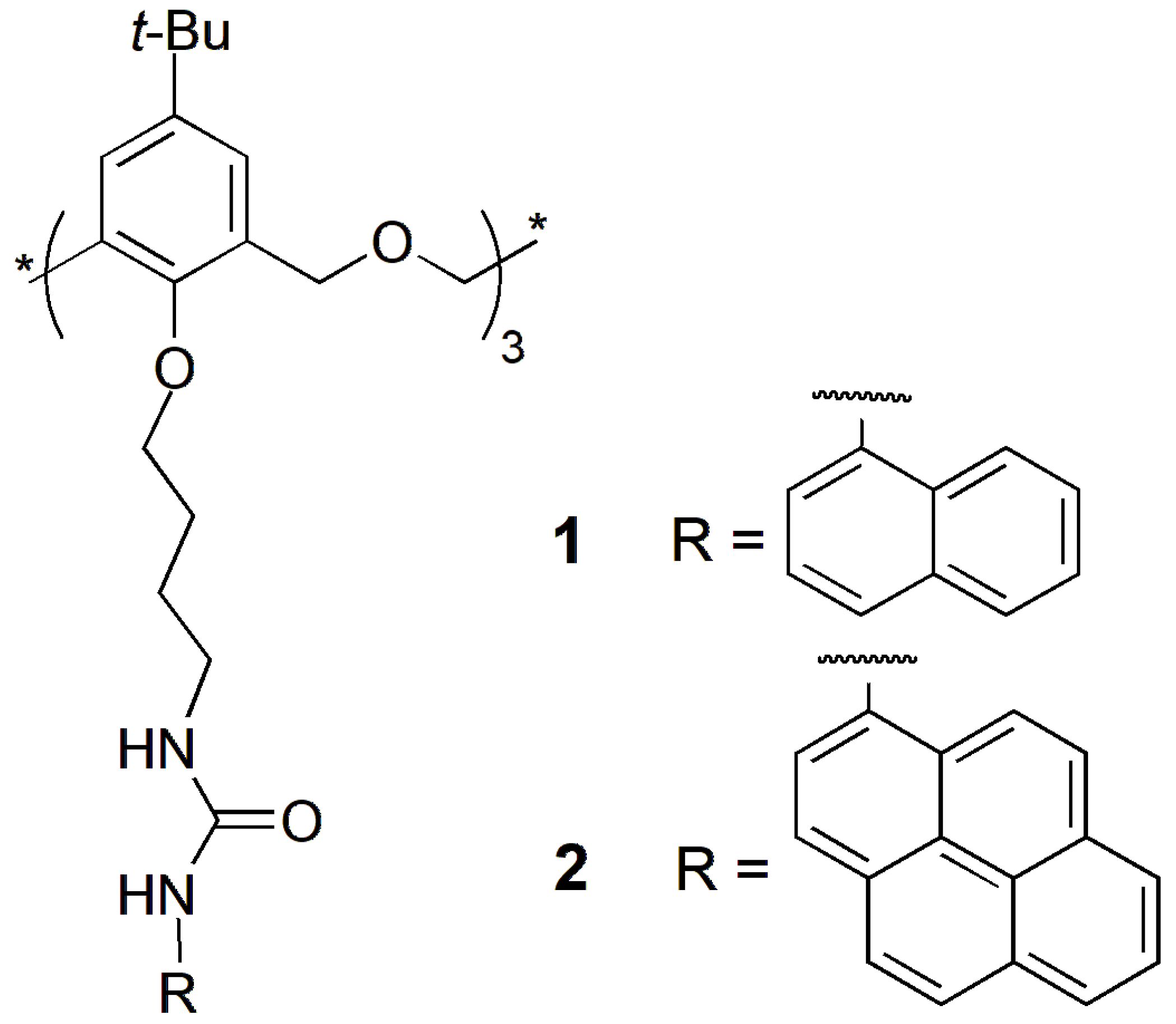

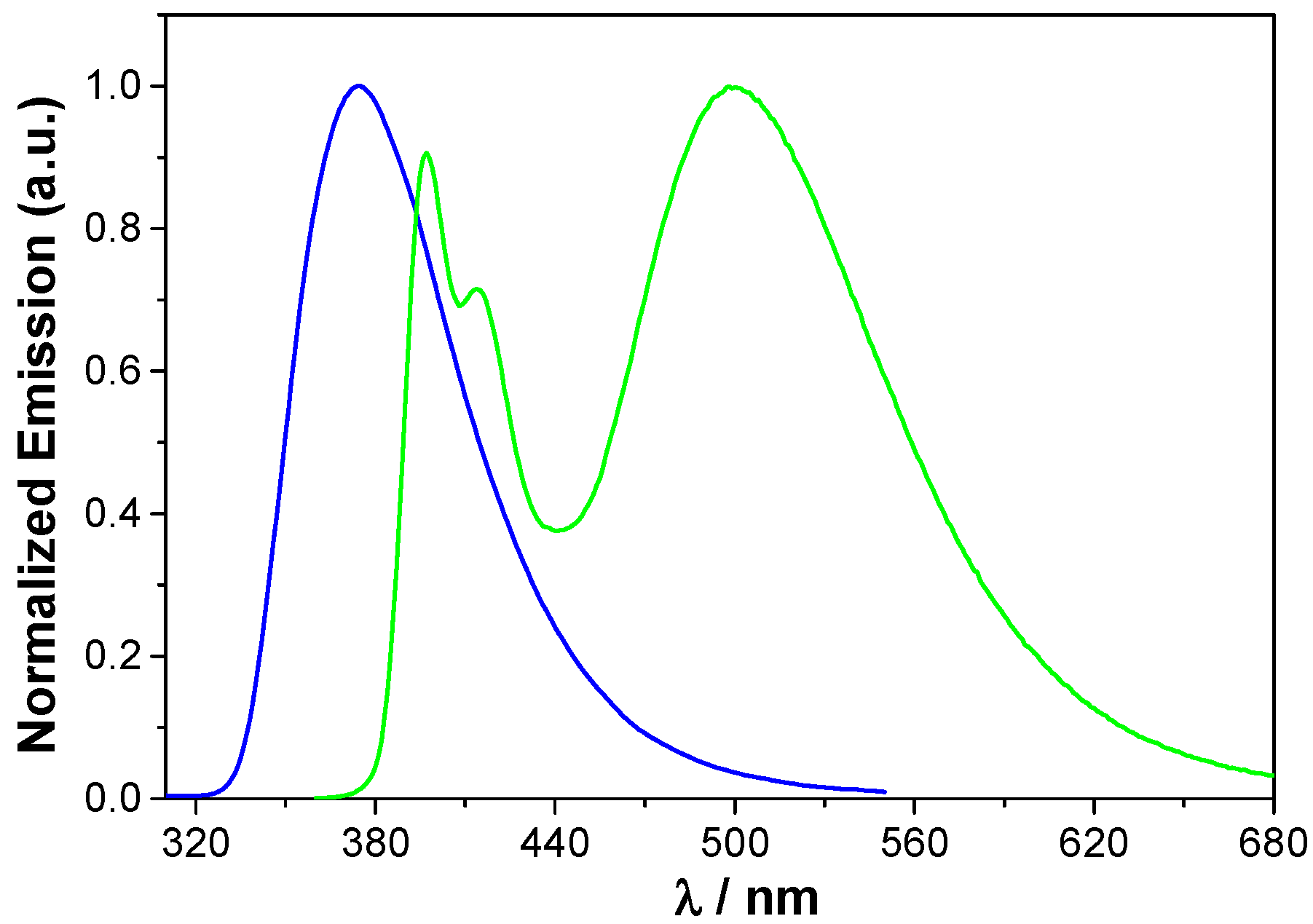
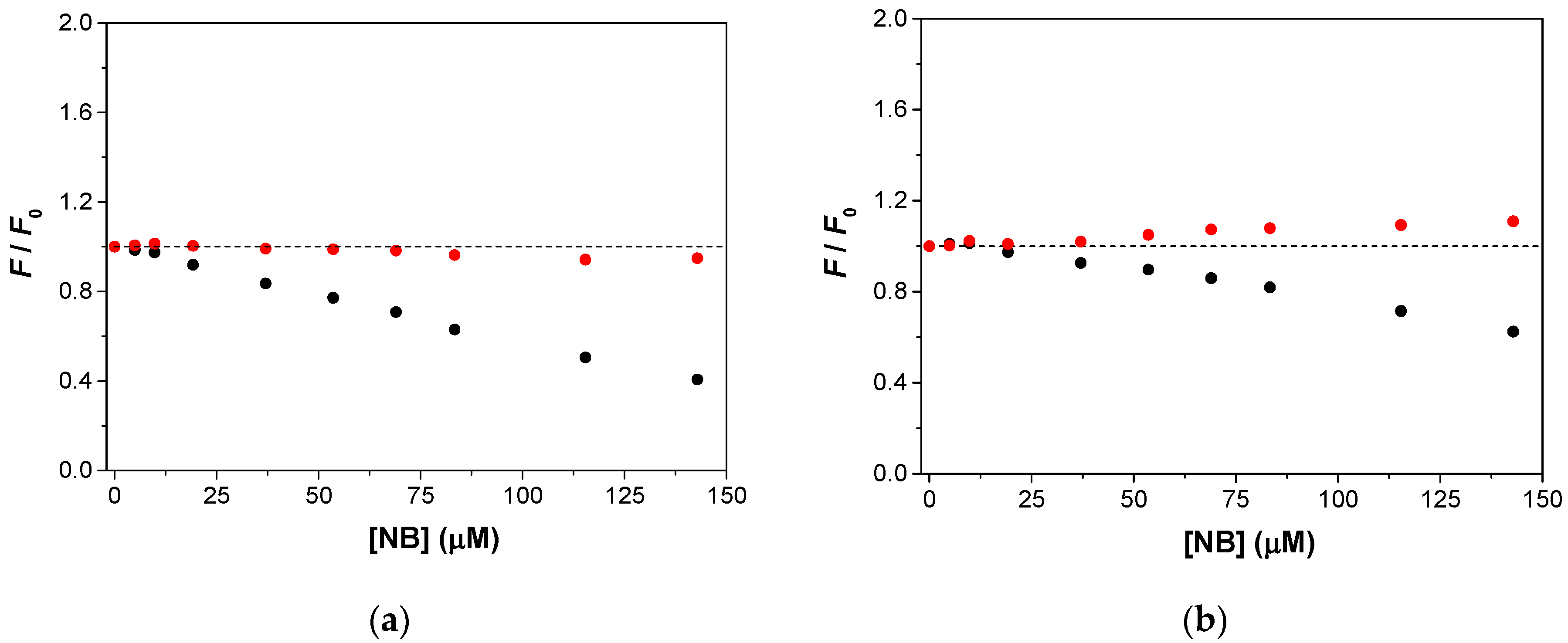
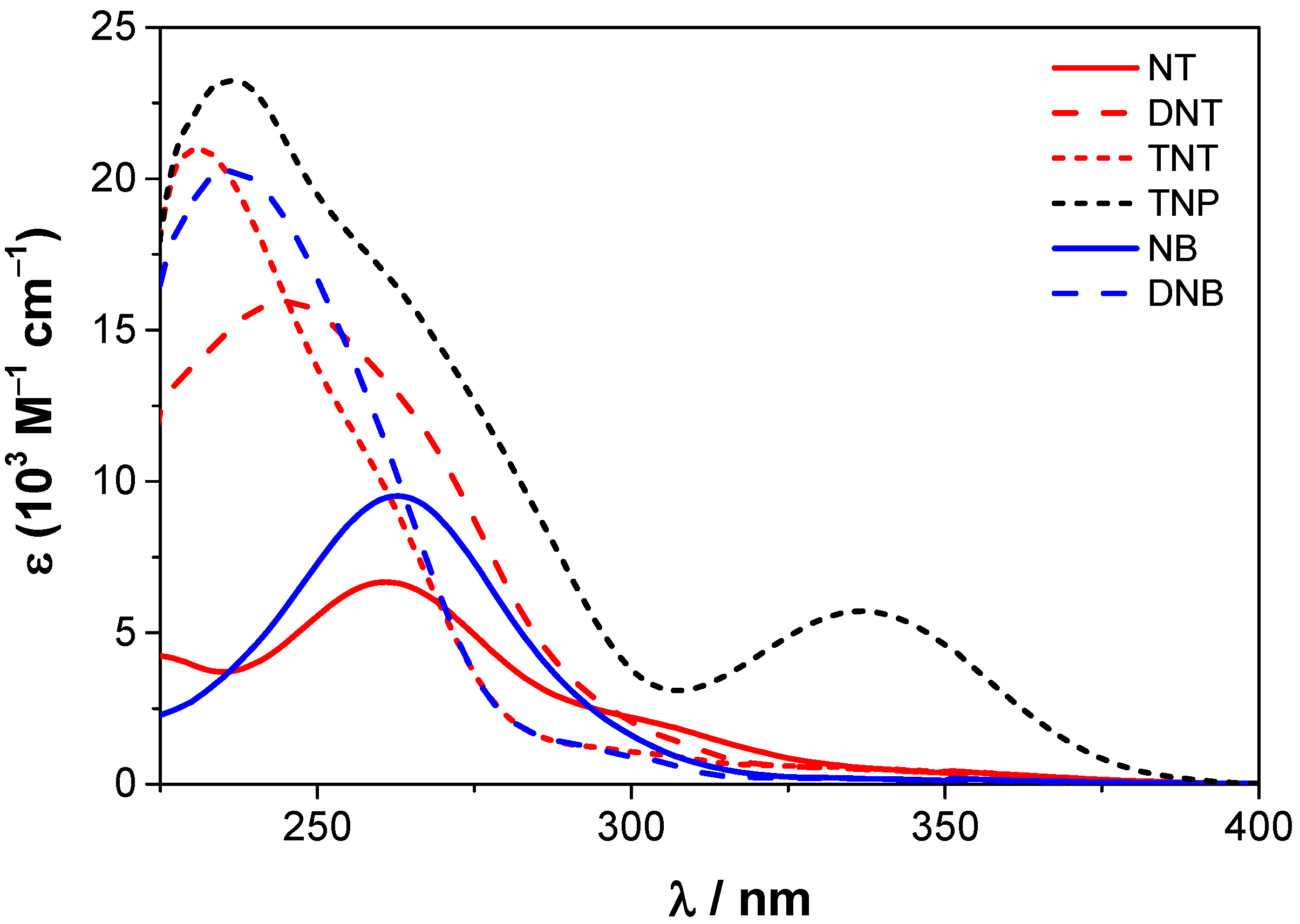
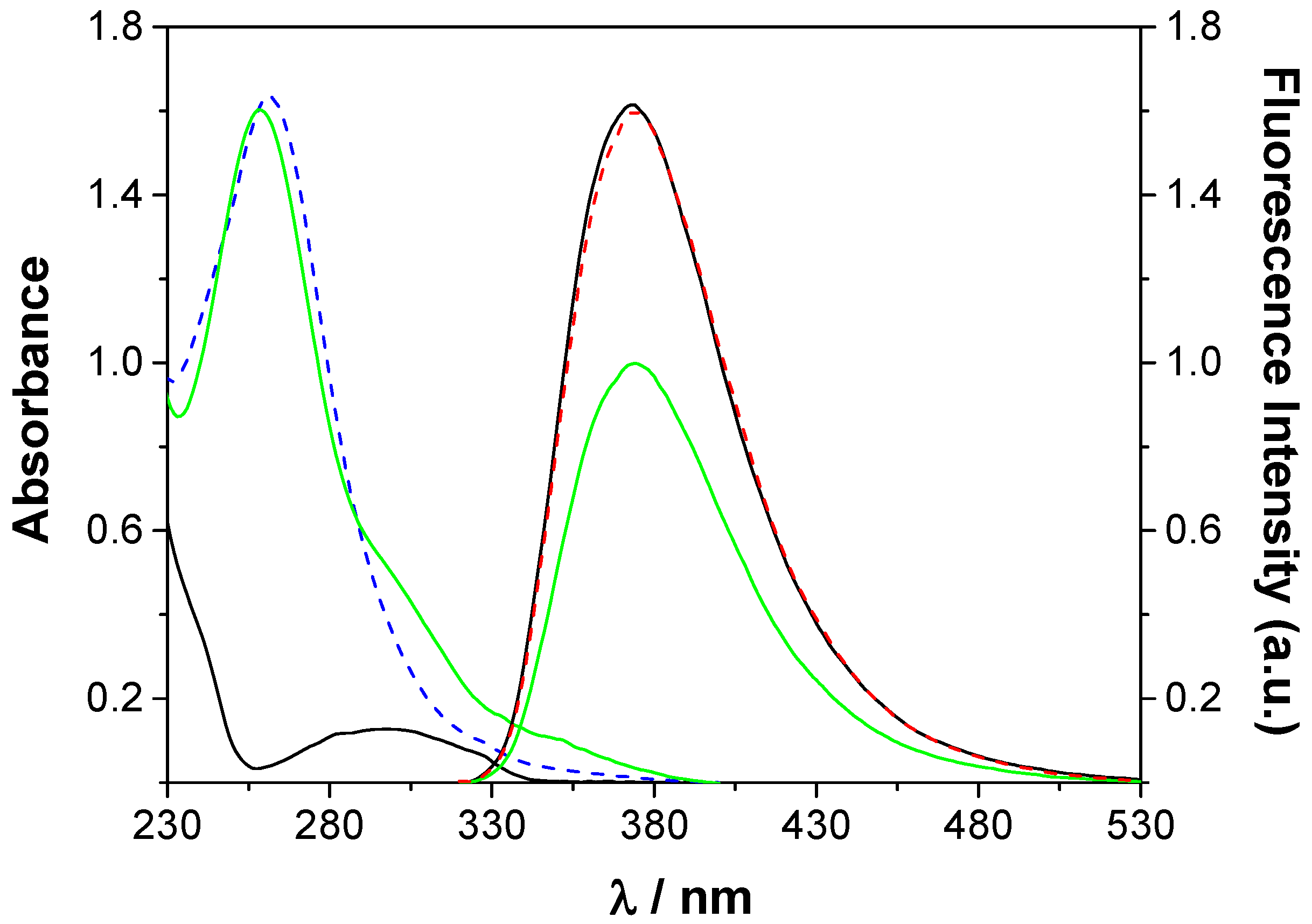
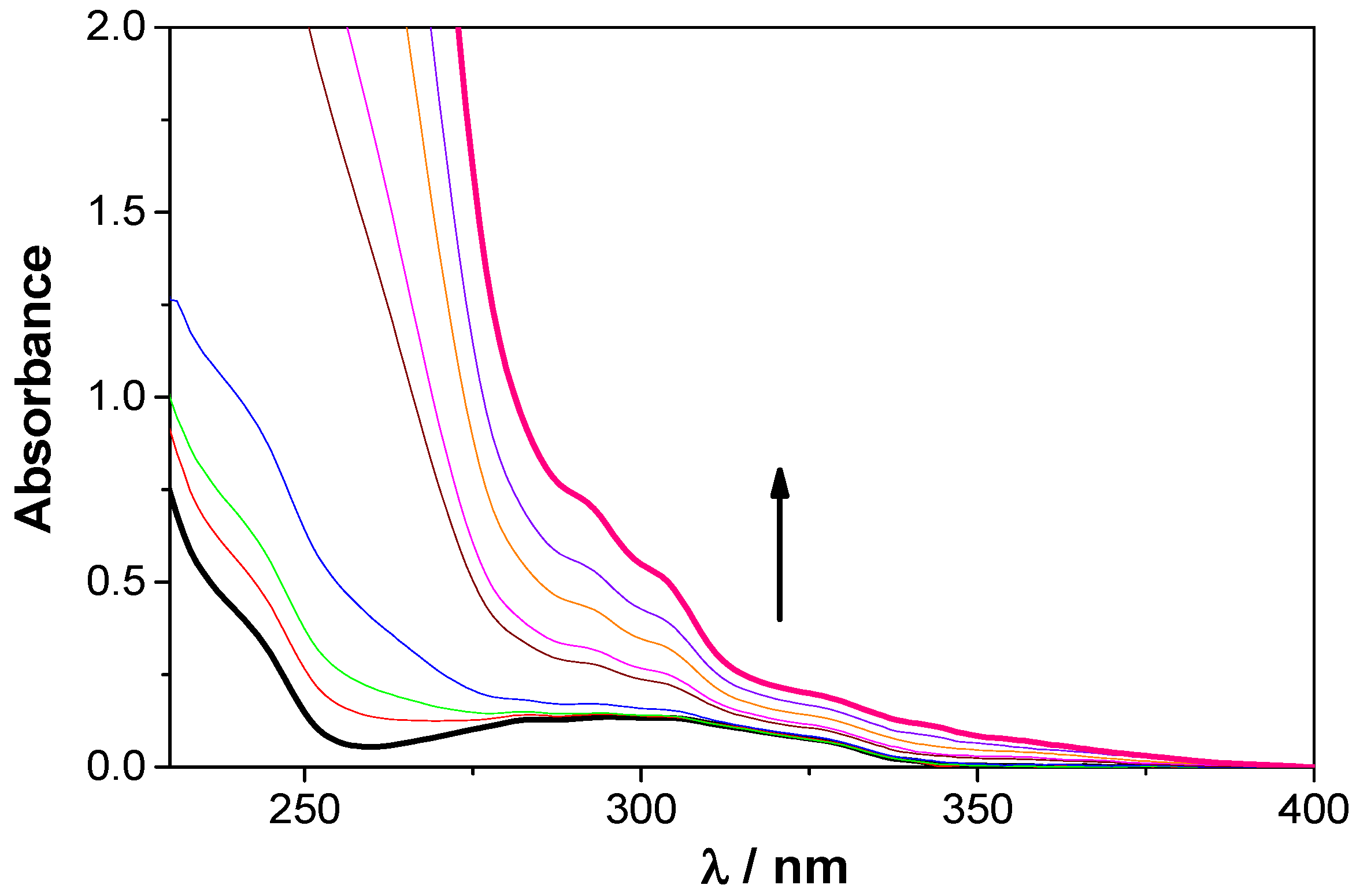
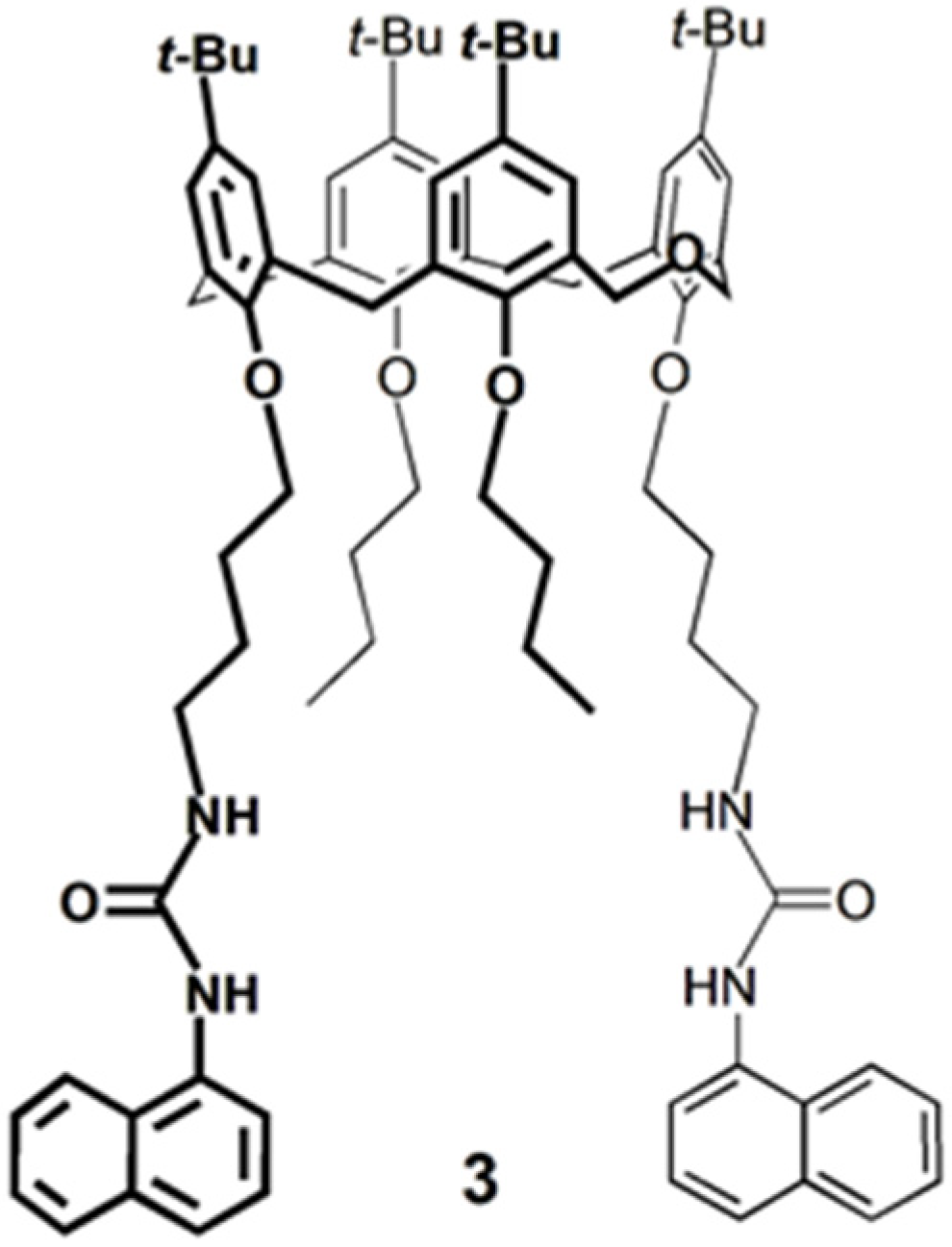
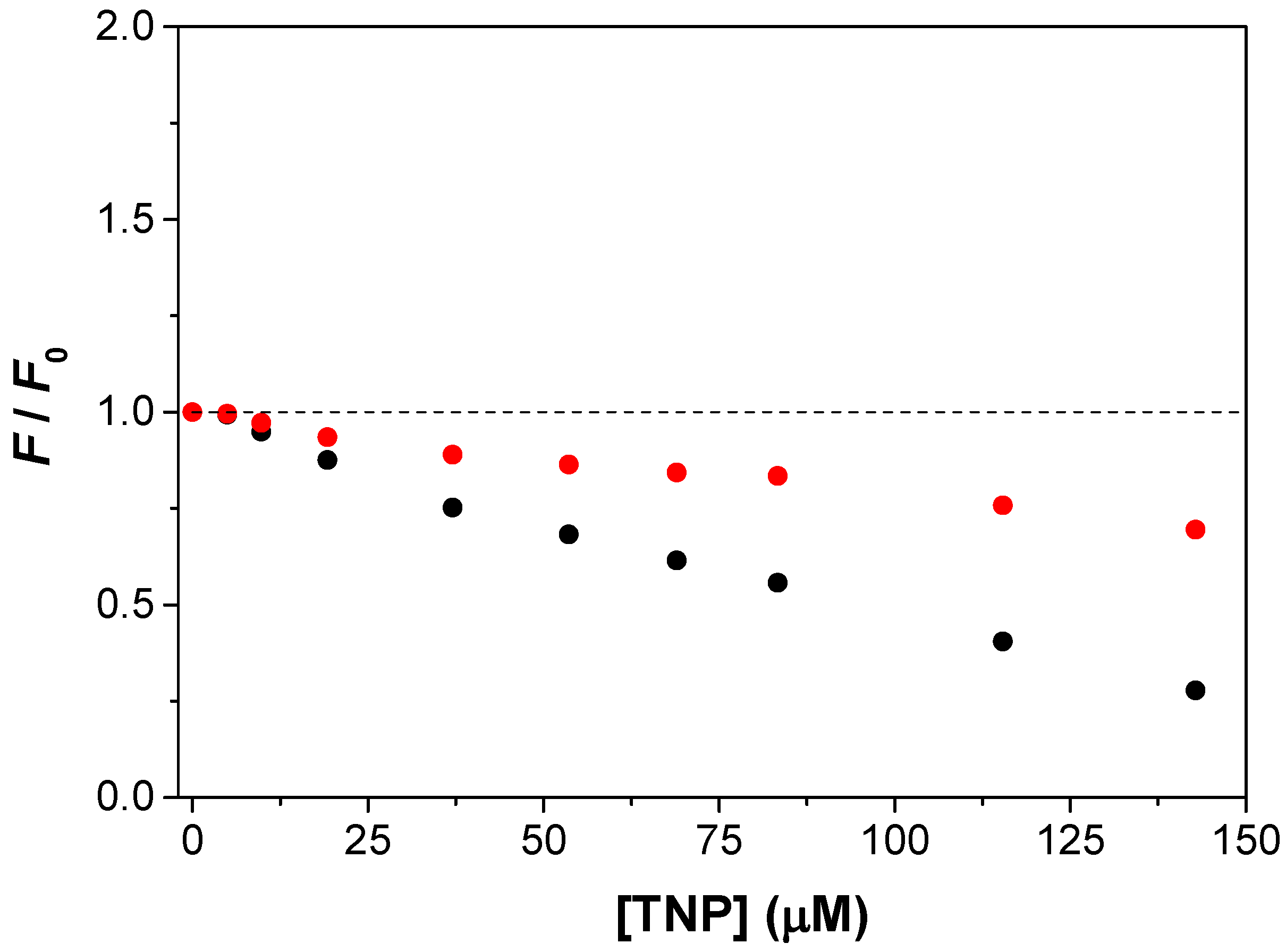
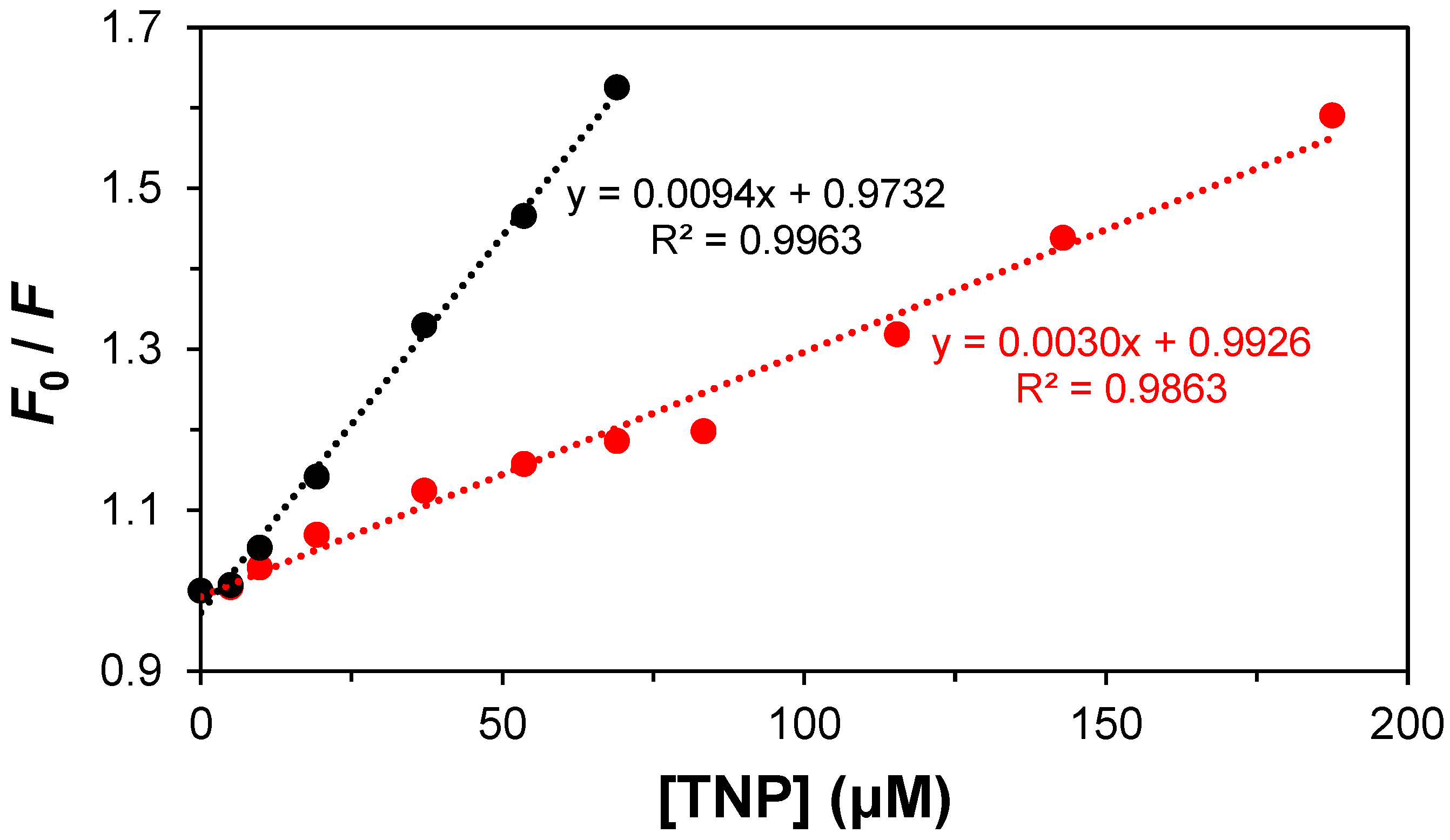

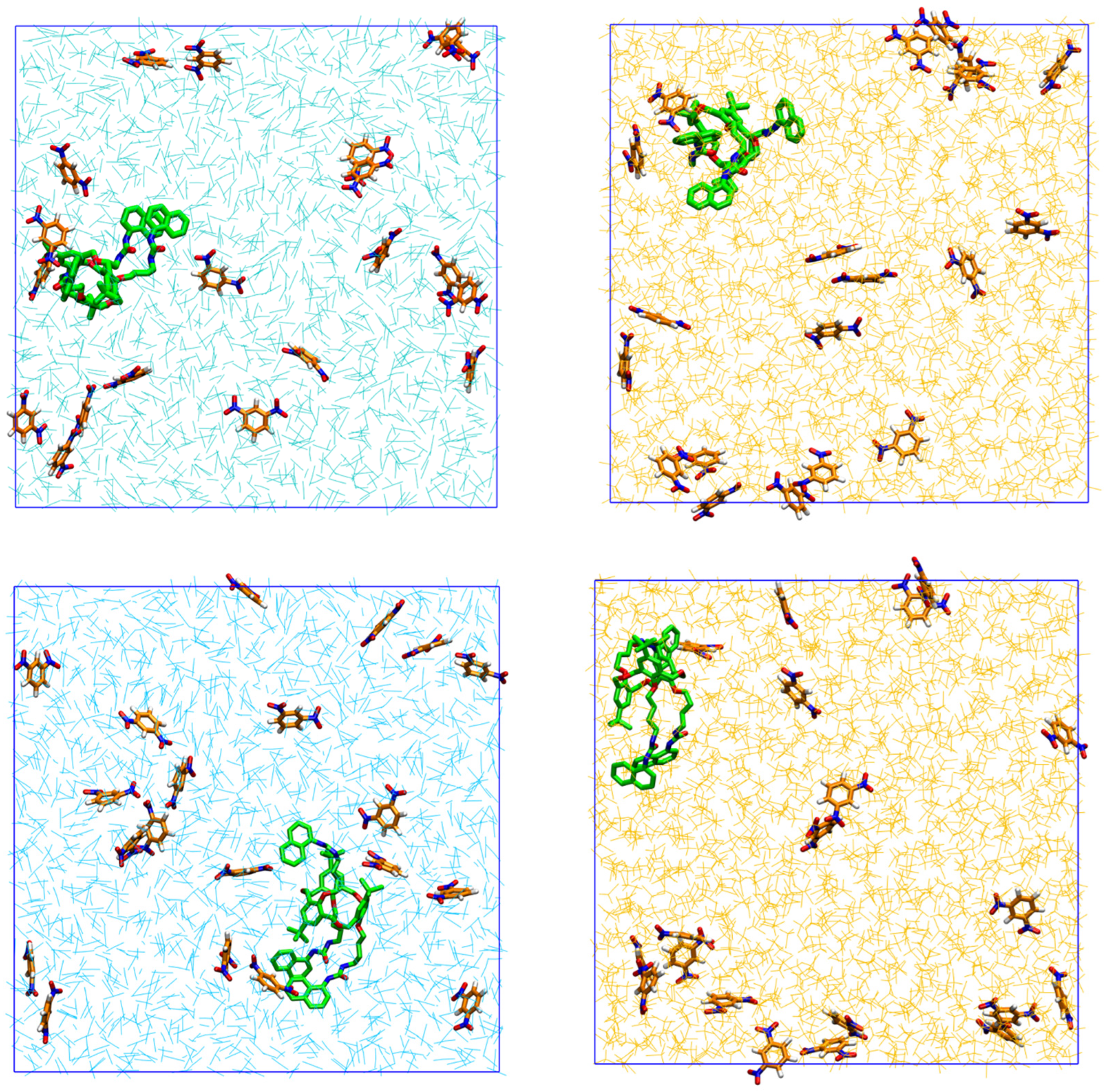
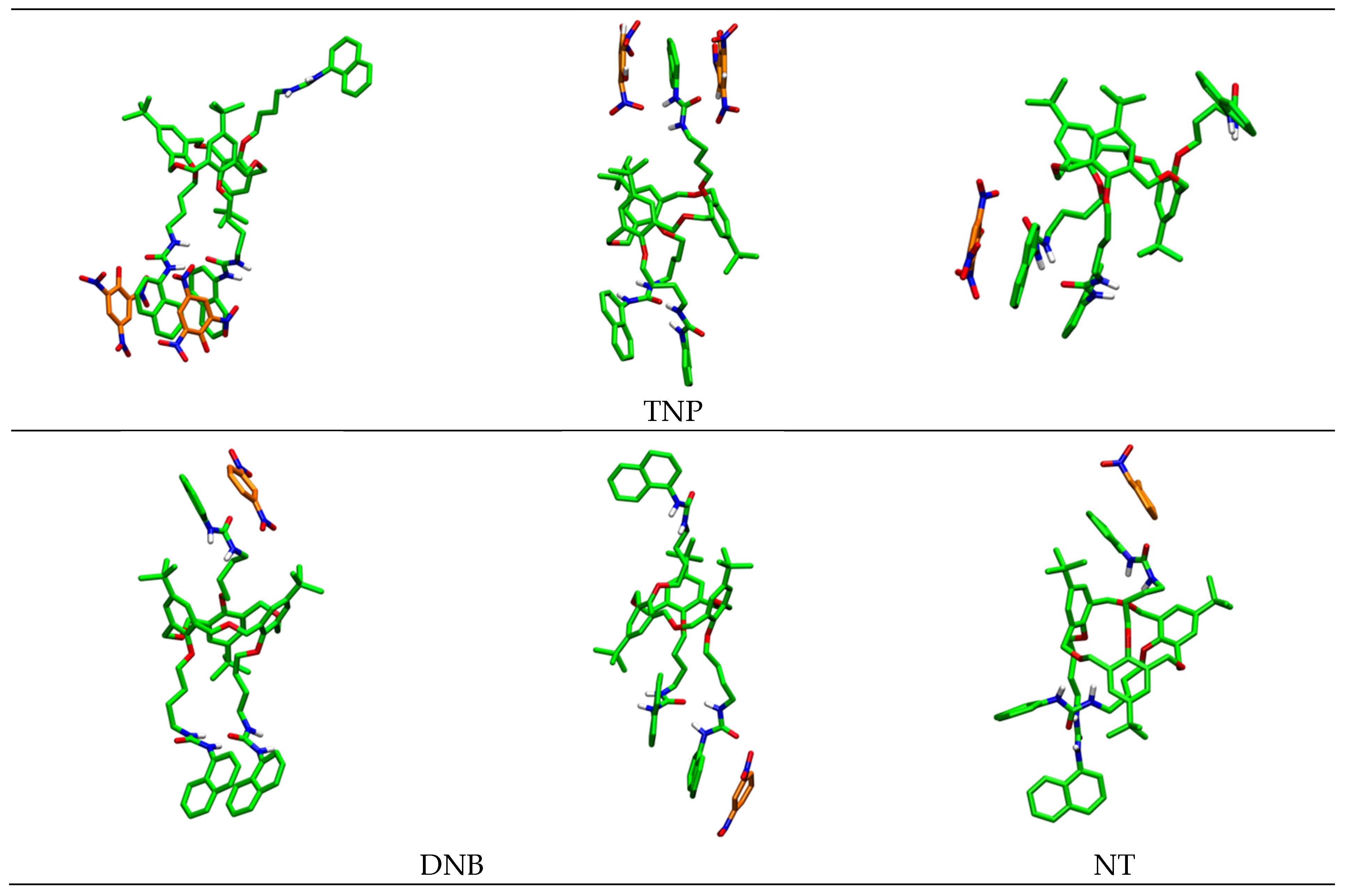
| Solvent | NT | DNT | TNT | TNP | NB | DNB | |
|---|---|---|---|---|---|---|---|
| 1 | CH2Cl2 | <0.1 | <0.1 | <0.1 | 0.5 | <0.1 | <0.1 |
| MeCN | <0.1 | <0.1 | <0.1 | <0.1 | <0.1 | <0.1 | |
| 2 | CH2Cl2 | <0.1 | <0.1 | <0.1 | <0.1 | <0.1 | <0.1 |
| /ns (%) | /ns (%) | /ns (%) | /ns | |
|---|---|---|---|---|
| 1 * | 0.35 (6) | 2.6 (59) | 9.3 (35) | 4.8 |
| 1 + NT | 0.33 (6) | 2.5 (58) | 8.6 (36) | 4.6 |
| 1 + DNT | 0.37 (6) | 2.6 (59) | 9.1 (35) | 4.7 |
| 1 + TNT | 0.39 (6) | 2.7 (60) | 9.4 (34) | 4.8 |
| 1 + TNP | 0.33 (6) | 2.5 (57) | 8.7 (37) | 4.6 |
| 1 + NB | 0.35 (6) | 2.6 (58) | 9.0 (36) | 4.7 |
| 1 + DNB | 0.35 (6) | 2.6 (58) | 8.8 (36) | 4.7 |
| /ns (%) | /ns (%) | /ns (%) | /ns | |
|---|---|---|---|---|
| 3 * | 0.26 (10) | 2.2 (12) | 11.2 (78) | 9.0 |
| 3 + 4 equiv. TNP | 0.25 (10) | 2.0 (12) | 10.9 (78) | 8.7 |
| 3 + 10 equiv. TNP | 0.24 (10) | 2.1 (12) | 10.8 (77) | 8.6 |
| 1 | ||
|---|---|---|
| M | P | |
| NT | 9.2 | 3.3 |
| DNT | −0.4 | 3.3 |
| TNT | 2.1 | 1.7 |
| TNP | −1.7 | −13.0 |
| NB | 12.6 | 8.8 |
| DNB | 9.6 | 2.5 |
| TNP | DNB | NT | ||
|---|---|---|---|---|
| MeCN | E | −110 ± 75 | −29 ± 35 | −11 ± 15 |
| −123 ± 52 | −31 ± 31 | −13 ± 16 | ||
| −123 ± 52 | −22 ± 26 | −12 ± 16 | ||
| N | 0.54/0.34/0.82 ± 0.68 (24–35) | 0.30/0.26/0.30 ± 0.52 (22–35) | 0.21/0.18/0.13 ± 0.42 (14–15) | |
| 0.74/0.41/0.50 ± 0.58 (20–34) | 0.32/0.23/0.44 ± 0.47 (20–35) | 0.17/0.16/0.17 ± 0.43 (14–15) | ||
| 0.30/0.37/0.97 ± 0.53 (24–28) | 0.24/0.27/0.17 ± 0.51 (25–30) | 0.19/0.17/0.17 ± 0.41 (12–15) | ||
| CH2Cl2 | E | −246 ± 97 | −86 ± 50 | −17 ± 20 |
| −336 ± 60 | −59 ± 39 | −18 ± 19 | ||
| −247 ± 71 | −93 ± 61 | −35 ± 29 | ||
| N | 1.98/1.53/1.38 ± 0.68 (50–90) | 0.58/0.33/0.83 ± 0.50 (21–37) | 0.27/0.21/0.22 ± 0.42 (12–15) | |
| 1.30/1.69/1.79 ± 0.60 (50–110) | 0.33/0.51/0.23 ± 0.52 (15–30) | 0.20/0.19/0.26 ± 0.40 (14–16) | ||
| 1.39/1.10/1.56 ± 0.55 (40–85) | 0.43/0.51/0.54 ± 0.45 (28–40) | 0.32/0.21/0.27 ± 0.42 (14–16) |
Disclaimer/Publisher’s Note: The statements, opinions and data contained in all publications are solely those of the individual author(s) and contributor(s) and not of MDPI and/or the editor(s). MDPI and/or the editor(s) disclaim responsibility for any injury to people or property resulting from any ideas, methods, instructions or products referred to in the content. |
© 2023 by the authors. Licensee MDPI, Basel, Switzerland. This article is an open access article distributed under the terms and conditions of the Creative Commons Attribution (CC BY) license (https://creativecommons.org/licenses/by/4.0/).
Share and Cite
Miranda, A.S.; Marcos, P.M.; Ascenso, J.R.; Berberan-Santos, M.N.; Cragg, P.J.; Schurhammer, R.; Gourlaouen, C. Critical Analysis of Association Constants between Calixarenes and Nitroaromatic Compounds Obtained by Fluorescence. Implications for Explosives Sensing. Molecules 2023, 28, 3052. https://doi.org/10.3390/molecules28073052
Miranda AS, Marcos PM, Ascenso JR, Berberan-Santos MN, Cragg PJ, Schurhammer R, Gourlaouen C. Critical Analysis of Association Constants between Calixarenes and Nitroaromatic Compounds Obtained by Fluorescence. Implications for Explosives Sensing. Molecules. 2023; 28(7):3052. https://doi.org/10.3390/molecules28073052
Chicago/Turabian StyleMiranda, Alexandre S., Paula M. Marcos, José R. Ascenso, Mário N. Berberan-Santos, Peter J. Cragg, Rachel Schurhammer, and Christophe Gourlaouen. 2023. "Critical Analysis of Association Constants between Calixarenes and Nitroaromatic Compounds Obtained by Fluorescence. Implications for Explosives Sensing" Molecules 28, no. 7: 3052. https://doi.org/10.3390/molecules28073052
APA StyleMiranda, A. S., Marcos, P. M., Ascenso, J. R., Berberan-Santos, M. N., Cragg, P. J., Schurhammer, R., & Gourlaouen, C. (2023). Critical Analysis of Association Constants between Calixarenes and Nitroaromatic Compounds Obtained by Fluorescence. Implications for Explosives Sensing. Molecules, 28(7), 3052. https://doi.org/10.3390/molecules28073052









